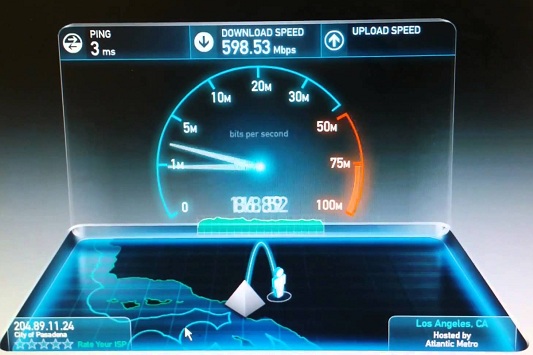No doubts fiber optic internet speed is the fastest speed in the world. If you are willing to know what internet speed is available in your home or office, you need to explore the fiber optic internet packages offered by the service provider.
Having a fiber optic internet connection does not make you eligible for highest speed but it depends upon the package you have the subscription. There is no other question that only fiber optic can give you the best speed anywhere in the world.
At the end of this page the list of top 10 countries having fastest fiber optic internet speed is given. If you are living in any of these countries then you might be already enjoying the fastest available internet connection in your country.
Which Country is having Faster Fiber Optic Internet
Currently South Korea tops in the fiber optic internet speeds of 28.6 Mbps as an average and overall 40 percent of South Korean population is enjoying the connectivity speeds above 25 Mbps. This number is much far bigger than the average of global population i.e. 12 percent only.
In recent years most of the countries are investing the fiber optic internet because the demand for high data transfer is increasing drastically. The major role in this increase of demand is use of high definition cameras, TV’s and mobile phones, which ultimately in combination with social media puts pressure on internet speeds.
For example if you are using a slow typical internet connection of 1Mbps you may need 15-20 minutes to upload or send a video file of size 200mb. Instead if you are using fiber optic internet of 20Mbps you may finish the sharing of file within 1-2 minutes.
Where to Buy Fiber Optic Internet
High speed fiber optic internet has become the need of the day for all modern cities because new generation is now playing online games which are connected to the game servers. An average home user is now looking for best choices and good offers from internet service providers and the competition is on.
You have to search Google for your local area optical fiber internet service providers. Then you have to wisely select the packages with respect to the internet speed and total download limits. You can search like “Best Internet Provider in my City” and rest Google will search depending upon your locality set in your computer or mobile device.
Top 10 Fastest Internet Speed Countries, as of first quarter of 2017.
The average global internet connectivity speed was 7.2 megabits per second (Mbps) in the first quarter of 2017, a 15 percent increase from the same time frame in 2016, according to a report from Akamai.
| Position | Country Name | Average internet connectivity speed |
| 1. | South Korea | 28.6 Mbps |
| 2. | Norway | 23.5 Mbps |
| 3. | Sweden | 22.5 Mbps |
| 4. | Hong Kong | 21.9 Mbps |
| 5. | Switzerland | 21.7 Mbps |
| 6. | Finland | 20.5 Mbps |
| 7. | Singapore | 20.3 Mbps |
| 8. | Japan | 20.2 Mbps |
| 9. | Denmark | 20.1 Mbps |
| 10. | United States | 18.7 Mbps |
Comparing Different Types of Internet Connections
Dial-Up (Analog 56K) Old Times but still working
Dial-up access is cheap but slow. A modem (internal or external) connects to the Internet after the computer dials a phone number. This analog signal is converted to digital via the modem and sent over a land-line serviced by a public telephone network. Telephone lines are variable in quality and the connection can be poor at times. The lines regularly experience interference and this affects the speed, anywhere from 28K to 56K. Since a computer or other device shares the same line as the telephone, they can’t be active at the same time.
DSL. DSL stands for Digital Subscriber Line. It is an internet connection that is always “on”. This uses 2 lines so your phone is not tied up when your computer is connected. There is also no need to dial a phone number to connect. DSL uses a router to transport data and the range of connection speed, depending on the service offered, is between 128K to 8 Mbps.
Cable. Cable provides an internet connection through a cable modem and operates over cable TV lines. There are different speeds depending on if you are uploading data transmissions or downloading. Since the coax cable provides a much greater bandwidth over dial-up or DSL telephone lines, you can get faster access. Cable speeds range from 512K to 20 Mbps.
Wireless. Wireless, or Wi-Fi, as the name suggests, does not use telephone lines or cables to connect to the internet. Instead, it uses radio frequency. Wireless is also an always on connection and it can be accessed from just about anywhere. Speeds will vary, and the range is between 5 Mbps to 20 Mbps.
Satellite. Satellite accesses the internet via a satellite in Earth’s orbit. The enormous distance that a signal travels from earth to satellite and back again, provides a delayed connection compared to cable and DSL. Satellite connection speeds are around 512K to 2.0 Mbps.
Cellular. Cellular technology provides wireless Internet access through cell phones. The speeds vary depending on the provider, but the most common are 3G and 4G speeds. A 3G is a term that describes a 3rd generation cellular network obtaining mobile speeds of around 2.0 Mbps. 4G is the fourth generation of cellular wireless standards. The goal of 4G is to achieve peak mobile speeds of 100 Mbps but the reality is about 21 Mbps currently. Next level is 5G which is also becoming famous at user level.
Optical Fiber Internet: This is the fastest internet technology as of now and its speed is increasing day by day.
Discover more from Electrical Engineering 123
Subscribe to get the latest posts sent to your email.
